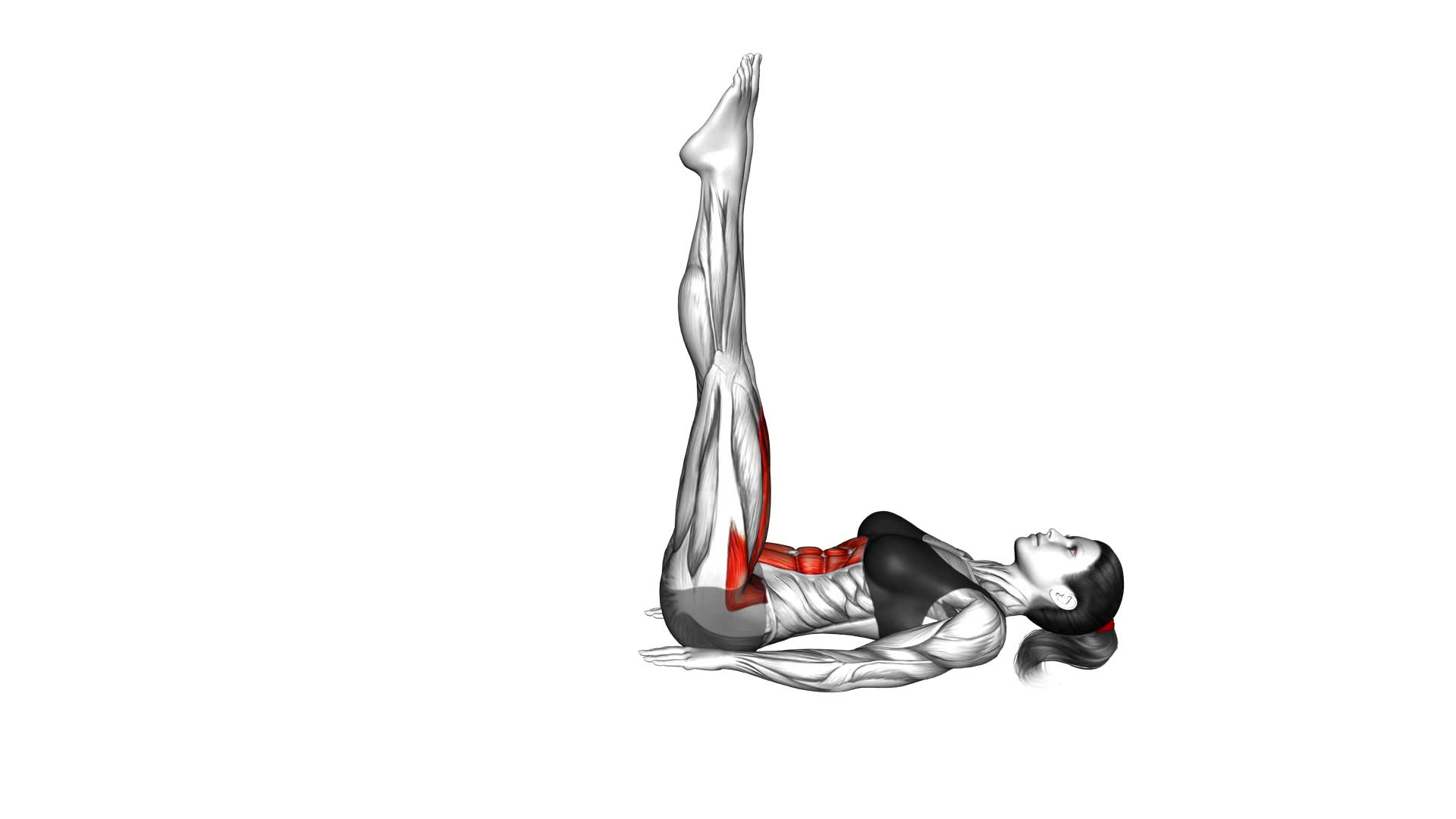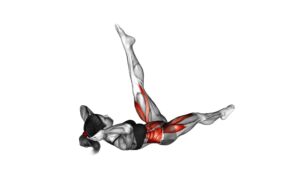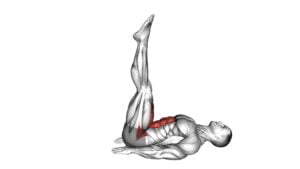Lying Single Leg Raise (female) – Video Exercise Guide & Tips

Get ready to strengthen your legs with the lying single leg raise! This exercise targets your glutes, hamstrings, and quads, helping you build strength and stability.
Watch This Exercise Video
In this video exercise guide, you'll learn the proper form and technique for the lying single leg raise, along with helpful tips to maximize your results.
Grab a mat and get ready to take your leg workout to the next level!
Key Takeaways
- Lying Single Leg Raise targets glutes, hamstrings, and quadriceps.
- It improves lower body strength, stability, balance, and coordination.
- Proper form and technique include engaging core muscles, maintaining a straight line from hip to toes, and avoiding holding breath.
- The exercise can be modified with additional equipment or progressions, but can also be done without any equipment.
Benefits of Lying Single Leg Raise
You can experience several benefits from performing the lying single leg raise exercise. This exercise primarily targets the muscles in your lower body, including your glutes, hamstrings, and quadriceps. By strengthening these muscles, you can improve your overall lower body strength and stability. Additionally, the lying single leg raise can help improve your balance and coordination, as it requires you to engage your core and maintain stability throughout the movement.
Another benefit of this exercise is that it can help prevent and alleviate lower back pain. By strengthening the muscles in your lower body, you can provide better support to your spine and reduce the risk of injury.
Moreover, the lying single leg raise exercise can be modified to suit different fitness levels and goals. If you're a beginner, you can start by performing the exercise with both legs on the ground, gradually progressing to lifting one leg at a time. For a more advanced variation, you can add ankle weights or resistance bands to increase the intensity of the exercise.
Proper Form and Technique
To ensure proper form and technique during the lying single leg raise exercise, it's important to maintain a controlled and stable movement throughout. This will help you avoid injuries and effectively activate the targeted muscles.
When performing the lying single leg raise, start by lying on your back with your legs extended. Keep your arms by your sides for support. Engage your core muscles by drawing your belly button towards your spine. This will help stabilize your pelvis and lower back.
Next, lift one leg off the ground while keeping the other leg straight and grounded. Avoid using momentum or swinging your leg up. Instead, use your hip flexor muscles to lift your leg in a slow and controlled manner. This ensures proper muscle activation and reduces the risk of strain or injury.
As you raise your leg, aim to maintain a straight line from your hip to your toes. Avoid arching your back or lifting your hips off the ground. Keep your movements smooth and controlled throughout the exercise.
Remember to breathe steadily and avoid holding your breath during the exercise. Exhale as you lift your leg and inhale as you lower it back down.
Equipment Needed for the Exercise
To properly perform the lying single leg raise exercise, you'll need some essential exercise equipment. This includes a yoga mat or exercise mat to provide cushioning and support for your body.
Additionally, you may want to use a resistance band or ankle weights to add intensity to the exercise.
If you don't have access to these specific items, you can also use alternatives such as a towel or pillow for the mat and water bottles or cans for the weights.
Essential Exercise Equipment
To perform the lying single leg raise exercise, all you need is a mat or a comfortable surface to lie on. This exercise doesn't require any additional equipment, making it a convenient option for those who prefer to work out at home. By using just your body weight and the floor, you can effectively target your core and lower body muscles.
If you don't have a mat, you can use a towel or blanket as a substitute. Additionally, if you're looking for alternative exercises to the lying single leg raise, you can try variations such as the standing leg raise or the seated leg raise. These exercises provide similar benefits and can be done without any equipment as well.
Now, let's explore alternatives to traditional equipment.
Alternatives to Traditional Equipment?
You will need some equipment for the lying single leg raise exercise. However, if you don't have access to traditional exercise equipment, there are alternatives you can try.
Bodyweight exercises are a great option for home workouts, as they don't require any equipment. Instead of using a bench or a stability ball, you can lie on the floor or on a mat to perform the single leg raise.
Simply extend one leg straight up while keeping the other leg bent with the foot on the ground. This exercise targets your core, hips, and glutes without the need for any equipment.
It's a convenient and effective alternative for those who prefer to exercise at home.
Modifications and Progressions
As you progress in your fitness journey, consider incorporating modifications and progressions into your lying single leg raise exercise. These modifications allow you to tailor the exercise to your current fitness level and work towards more advanced variations.
One modification you can try is to perform the exercise with your hands placed under your hips for added support. This can help stabilize your lower back and make the exercise more accessible if you're just starting out.
To increase the difficulty of the exercise, you can try performing the lying single leg raise with ankle weights. Adding extra resistance challenges your muscles and helps to further strengthen your core and hip flexors.
Another advanced variation is the single leg raise with a medicine ball. Holding the ball between your feet adds an element of instability, engaging your core muscles even more. Be sure to start with a lighter weight and gradually increase as you become more comfortable and stronger.
By incorporating these modifications and progressions into your lying single leg raise exercise, you can continue to challenge your muscles and make progress in your fitness journey.
Now, let's move on to the next section where we'll discuss common mistakes to avoid.
Common Mistakes to Avoid
To ensure proper form during the lying single leg raise, there are a few key techniques you should focus on.
Firstly, make sure to keep your core engaged throughout the exercise to avoid unnecessary strain on your lower back.
Additionally, be mindful of your leg alignment and avoid letting your knee collapse inward.
Proper Form Techniques
Are you unsure about how to execute the lying single leg raise correctly? Don't worry, we've got you covered.
Proper form is essential to get the most out of this exercise and prevent injuries. To ensure you're doing it right, start by lying flat on your back with one leg straight and the other bent at a 90-degree angle. Keep your core engaged and slowly lift your straight leg up towards the ceiling, making sure to maintain control and avoid any swinging motions.
If you find this exercise too challenging, you can try modifications like bending your knee slightly or using a resistance band for assistance. On the other hand, if you want to progress, you can add ankle weights or increase the number of repetitions.
Remember, proper form is crucial for maximizing the benefits of the lying single leg raise and avoiding unnecessary strain.
Avoiding Unnecessary Strain
To prevent unnecessary strain during the lying single leg raise, make sure you maintain control and avoid any swinging motions.
This exercise is designed to strengthen your hip flexors and core muscles, so it's important to perform it correctly to avoid injury and prevent muscle imbalances.
One common mistake to avoid is using momentum to swing your leg up instead of relying on your muscles to lift it. This can strain your lower back and diminish the effectiveness of the exercise.
Another mistake is letting your leg drop too quickly without control, which can also put unnecessary strain on your muscles.
Tips for Maximizing Results
For maximum results, incorporate regular resistance training into your workout routine. Resistance training not only helps build strength and endurance but also increases muscle mass, which can lead to improved performance and a more toned physique. Here are some tips to maximize your results and prevent injuries:
- Gradually increase the intensity: Start with lighter weights and gradually increase the resistance over time to challenge your muscles and promote growth. This progressive overload helps prevent plateaus and keeps your workouts effective.
- Focus on proper form: Performing exercises with correct form ensures that you're targeting the right muscles and maximizing the benefits. It also reduces the risk of injuries caused by improper technique.
- Allow for adequate recovery: Giving your muscles time to rest and recover is crucial for maximizing performance and preventing injuries. Aim for at least one day of rest between resistance training sessions and consider alternating muscle groups to allow for proper recovery.
- Incorporate variety: Mixing up your exercises and incorporating different resistance training techniques, such as using free weights, resistance bands, or machines, challenges your muscles in different ways and prevents boredom.
Frequently Asked Questions
How Many Repetitions of the Lying Single Leg Raise Should I Do?
You should determine the number of repetitions for the lying single leg raise based on your fitness level and goals.
It's recommended to start with 10-12 repetitions per leg and gradually increase as you get stronger.
The lying single leg raise is an effective exercise for strengthening your core, improving balance, and targeting your glutes and hamstrings.
It has different variations that you can incorporate to challenge yourself and add variety to your workout routine.
Can I Do the Lying Single Leg Raise Exercise if I Have a Knee Injury?
If you have a knee injury, it's important to be cautious with the lying single leg raise exercise. It may put too much strain on your knee and potentially worsen your injury.
Instead, focus on modifications or alternatives that are less strenuous on your knee. Speak with a healthcare professional or a certified trainer to learn which exercises are suitable for your condition and can help you strengthen your legs without causing further harm.
Should I Perform the Lying Single Leg Raise Exercise Before or After My Cardio Workout?
To maximize the benefits of your full body workout, you should perform the lying single leg raise exercise after your cardio session. This allows your muscles to be warmed up and ready for the exercise.
Incorporating this exercise into your routine can help strengthen your core, improve balance, and target the muscles in your legs and glutes.
Remember to consult with a fitness professional if you have any concerns about performing other exercises before or after cardio.
Is It Necessary to Use a Yoga Mat or Any Other Type of Mat for This Exercise?
You don't necessarily need a yoga mat or any other type of mat for the lying single leg raise exercise. However, using a mat can provide extra cushioning and support for your back and hips.
If you don't have a yoga mat, you can use alternative mats like a gym mat or a thick towel. Just make sure it's comfortable and stable enough for you to perform the exercise safely.
Can I Perform the Lying Single Leg Raise Exercise if I Have Lower Back Pain?
Yes, you can still perform the lying single leg raise exercise even if you have lower back pain. However, it's important to listen to your body and modify the exercise if needed.
If the exercise exacerbates your lower back pain, you may want to try alternative exercises that are less stressful on the lower back, such as bridges or bird dogs.
Remember to consult with a healthcare professional for personalized advice and guidance.
Conclusion
In conclusion, the lying single leg raise is a beneficial exercise for females looking to strengthen their core and lower body.
By following proper form and technique, using the necessary equipment, and avoiding common mistakes, you can maximize your results and achieve your fitness goals.
Remember to consult with a professional trainer or healthcare provider before starting any new exercise routine.

Author
Years ago, the spark of my life’s passion ignited in my mind the moment I stepped into the local gym for the first time. The inaugural bead of perspiration, the initial endeavor, the very first surge of endorphins, and a sense of pride that washed over me post-workout marked the beginning of my deep-seated interest in strength sports, fitness, and sports nutrition. This very curiosity blossomed rapidly into a profound fascination, propelling me to earn a Master’s degree in Physical Education from the Academy of Physical Education in Krakow, followed by a Sports Manager diploma from the Jagiellonian University. My journey of growth led me to gain more specialized qualifications, such as being a certified personal trainer with a focus on sports dietetics, a lifeguard, and an instructor for wellness and corrective gymnastics. Theoretical knowledge paired seamlessly with practical experience, reinforcing my belief that the transformation of individuals under my guidance was also a reflection of my personal growth. This belief holds true even today. Each day, I strive to push the boundaries and explore new realms. These realms gently elevate me to greater heights. The unique combination of passion for my field and the continuous quest for growth fuels my drive to break new ground.







